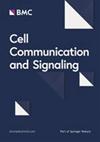Bivalent chromatin accommodates survivin and BRG1/SWI complex to activate DNA damage response in CD4+ cells
IF 8.2
2区 生物学
Q1 CELL BIOLOGY
引用次数: 0
Abstract
Bivalent regions of chromatin (BvCR) are characterized by trimethylated lysine 4 (H3K4me3) and lysine 27 on histone H3 (H3K27me3) deposition which aid gene expression control during cell differentiation. The role of BvCR in post-transcriptional DNA damage response remains unidentified. Oncoprotein survivin binds chromatin and mediates IFNγ effects in CD4+ cells. In this study, we explored the role of BvCR in DNA damage response of autoimmune CD4+ cells in rheumatoid arthritis (RA). We performed deep sequencing of the chromatin bound to survivin, H3K4me3, H3K27me3, and H3K27ac, in human CD4+ cells and identified BvCR, which possessed all three histone H3 modifications. Protein partners of survivin on chromatin were predicted by integration of motif enrichment analysis, computational machine-learning, and structural modeling, and validated experimentally by mass spectrometry and peptide binding array. Survivin-dependent change in BvCR and transcription of genes controlled by the BvCR was studied in CD4+ cells treated with survivin inhibitor, which revealed survivin-dependent biological processes. Finally, the survivin-dependent processes were mapped to the transcriptome of CD4+ cells in blood and in synovial tissue of RA patients and the effect of modern immunomodulating drugs on these processes was explored. We identified that BvCR dominated by H3K4me3 (H3K4me3-BvCR) accommodated survivin within cis-regulatory elements of the genes controlling DNA damage. Inhibition of survivin or JAK-STAT signaling enhanced H3K4me3-BvCR dominance, which improved DNA damage recognition and arrested cell cycle progression in cultured CD4+ cells. Specifically, BvCR accommodating survivin aided sequence-specific anchoring of the BRG1/SWI chromatin-remodeling complex coordinating DNA damage response. Mapping survivin interactome to BRG1/SWI complex demonstrated interaction of survivin with the subunits anchoring the complex to chromatin. Co-expression of BRG1, survivin and IFNγ in CD4+ cells rendered complete deregulation of DNA damage response in RA. Such cells possessed strong ability of homing to RA joints. Immunomodulating drugs inhibited the anchoring subunits of BRG1/SWI complex, which affected arthritogenic profile of CD4+ cells. BvCR execute DNA damage control to maintain genome fidelity in IFN-activated CD4+ cells. Survivin anchors the BRG1/SWI complex to BvCR to repress DNA damage response. These results offer a platform for therapeutic interventions targeting survivin and BRG1/SWI complex in autoimmunity.二价染色质容纳存活素和 BRG1/SWI 复合物,激活 CD4+ 细胞的 DNA 损伤反应
染色质二价区(BvCR)的特征是组蛋白 H3 上的三甲基化赖氨酸 4(H3K4me3)和赖氨酸 27(H3K27me3)沉积,有助于细胞分化过程中的基因表达控制。BvCR 在转录后 DNA 损伤反应中的作用仍未确定。肿瘤蛋白存活素与染色质结合,并在 CD4+ 细胞中介导 IFNγ 的效应。本研究探讨了 BvCR 在类风湿性关节炎(RA)自身免疫 CD4+ 细胞 DNA 损伤反应中的作用。我们对人类 CD4+ 细胞中与存活素结合的染色质、H3K4me3、H3K27me3 和 H3K27ac 进行了深度测序,发现 BvCR 具有这三种组蛋白 H3 修饰。通过整合主题富集分析、计算机器学习和结构建模,预测了染色质上存活素的蛋白伴侣,并通过质谱和肽结合阵列进行了实验验证。在使用存活素抑制剂处理的CD4+细胞中,研究了存活素依赖的BvCR变化和BvCR控制的基因转录,揭示了存活素依赖的生物学过程。最后,我们将生存素依赖过程绘制到了 RA 患者血液和滑膜组织中 CD4+ 细胞的转录组中,并探讨了现代免疫调节药物对这些过程的影响。我们发现,以 H3K4me3 为主导的 BvCR(H3K4me3-BvCR)将存活素容纳在控制 DNA 损伤的基因的顺式调控元件中。抑制存活素或JAK-STAT信号增强了H3K4me3-BvCR的优势,从而改善了DNA损伤识别能力,并阻止了培养的CD4+细胞的细胞周期进展。具体来说,BvCR容纳survivin有助于BRG1/SWI染色质重塑复合物的序列特异性锚定,从而协调DNA损伤反应。绘制存活素与BRG1/SWI复合物的相互作用组图显示了存活素与将复合物锚定在染色质上的亚基的相互作用。在CD4+细胞中联合表达BRG1、survivin和IFNγ可完全抑制RA的DNA损伤反应。这些细胞具有很强的RA关节归巢能力。免疫调节药物抑制了BRG1/SWI复合物的锚定亚基,从而影响了CD4+细胞的致关节炎特征。BvCR执行DNA损伤控制,以维持IFN激活的CD4+细胞基因组的保真度。Survivin 将 BRG1/SWI 复合物锚定在 BvCR 上,以抑制 DNA 损伤反应。这些结果为针对自身免疫中的存活素和BRG1/SWI复合物的治疗干预提供了一个平台。
本文章由计算机程序翻译,如有差异,请以英文原文为准。
求助全文
约1分钟内获得全文
求助全文
来源期刊

Cell Communication and Signaling
CELL BIOLOGY-
CiteScore
11.00
自引率
0.00%
发文量
180
期刊介绍:
Cell Communication and Signaling (CCS) is a peer-reviewed, open-access scientific journal that focuses on cellular signaling pathways in both normal and pathological conditions. It publishes original research, reviews, and commentaries, welcoming studies that utilize molecular, morphological, biochemical, structural, and cell biology approaches. CCS also encourages interdisciplinary work and innovative models, including in silico, in vitro, and in vivo approaches, to facilitate investigations of cell signaling pathways, networks, and behavior.
Starting from January 2019, CCS is proud to announce its affiliation with the International Cell Death Society. The journal now encourages submissions covering all aspects of cell death, including apoptotic and non-apoptotic mechanisms, cell death in model systems, autophagy, clearance of dying cells, and the immunological and pathological consequences of dying cells in the tissue microenvironment.
 求助内容:
求助内容: 应助结果提醒方式:
应助结果提醒方式:


